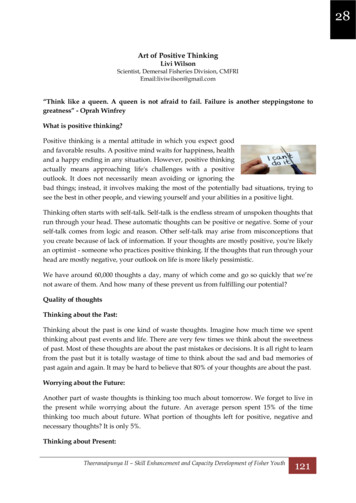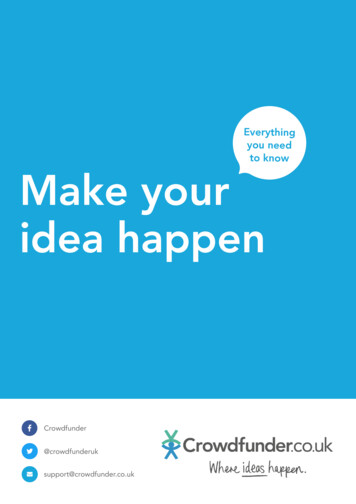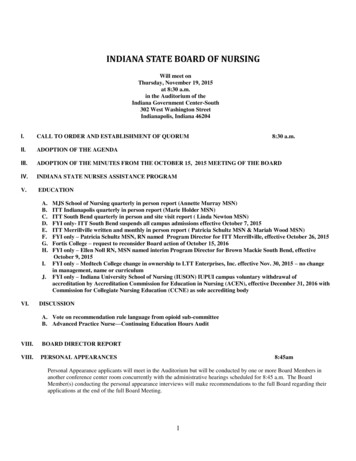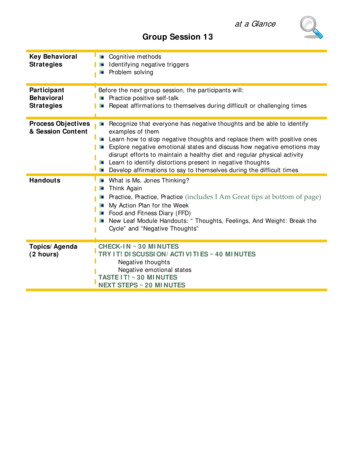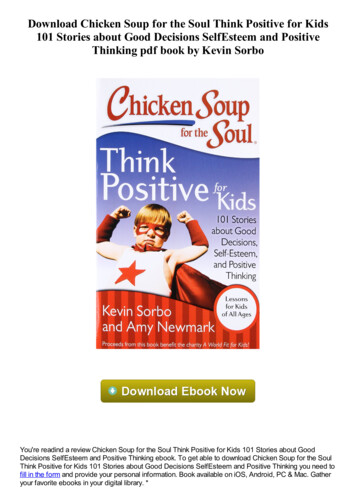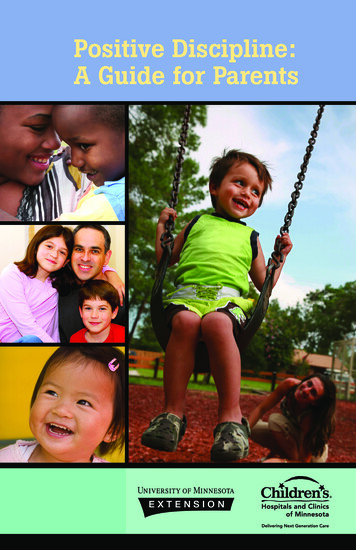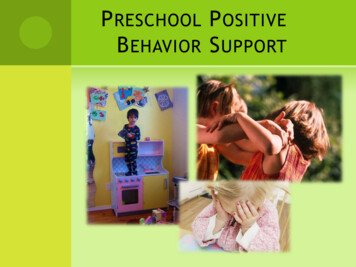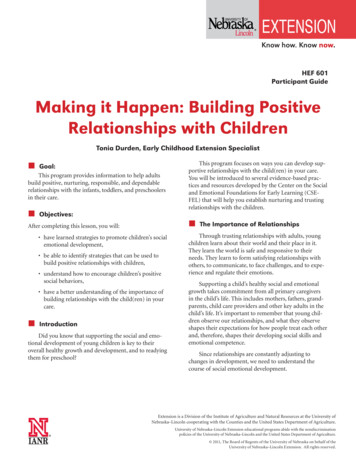
Transcription
Know how. Know now.HEF 601Participant GuideMaking it Happen: Building PositiveRelationships with ChildrenTonia Durden, Early Childhood Extension Specialist Goal:This program provides information to help adultsbuild positive, nurturing, responsible, and dependablerelationships with the infants, toddlers, and preschoolersin their care. Objectives:This program focuses on ways you can develop supportive relationships with the child(ren) in your care.You will be introduced to several evidence-based practices and resources developed by the Center on the Socialand Emotional Foundations for Early Learning (CSEFEL) that will help you establish nurturing and trustingrelationships with the children. The Importance of RelationshipsAfter completing this lesson, you will: have learned strategies to promote children’s socialemotional development, be able to identify strategies that can be used tobuild positive relationships with children, understand how to encourage children’s positivesocial behaviors, have a better understanding of the importance ofbuilding relationships with the child(ren) in yourcare. IntroductionDid you know that supporting the social and emotional development of young children is key to theiroverall healthy growth and development, and to readyingthem for preschool?Through trusting relationships with adults, youngchildren learn about their world and their place in it.They learn the world is safe and responsive to theirneeds. They learn to form satisfying relationships withothers, to communicate, to face challenges, and to experience and regulate their emotions.Supporting a child’s healthy social and emotionalgrowth takes commitment from all primary caregiversin the child’s life. This includes mothers, fathers, grandparents, child care providers and other key adults in thechild’s life. It’s important to remember that young children observe our relationships, and what they observeshapes their expectations for how people treat each otherand, therefore, shapes their developing social skills andemotional competence.Since relationships are constantly adjusting tochanges in development, we need to understand thecourse of social emotional development.Extension is a Division of the Institute of Agriculture and Natural Resources at the University ofNebraska–Lincoln cooperating with the Counties and the United States Department of Agriculture.University of Nebraska–Lincoln Extension educational programs abide with the nondiscriminationpolicies of the University of Nebraska–Lincoln and the United States Department of Agriculture. 2011, The Board of Regents of the University of Nebraska on behalf of theUniversity of Nebraska–Lincoln Extension. All rights reserved.
The Pyramid WayThe Pyramid Model focuses on the socialemotional development and school readinessof young children.To learn more about the Pyramid Model,visit: Center on the Social Emotional Foundations for Early Learning (CSEFEL )http://csefel.vanderbilt.edu/ The Early Childhood Training Center,http://www.education.ne.gov/oec/ectc.html, is part of the NebraskaDepartment of Education’s Officeof Early Childhood and providesstate leadership for Nebraska’s earlychildhood professional developmentsystem. Early Childhood FRIENDShttp://www.education.ne.gov/OEC/teaching pyramid/index.html —(Fostering Relationships and EmotionalHealth to Nurture DevelopmentalSuccess) utilizes the Pyramid Modelframework to promote the socialemotional development of youngchildren in Nebraska.Additional ResourceUniversity of Nebraska–Lincoln Resources on Early Childhood Development: http://child.unl.edu What is social emotional development?According to CSEFEL, the term social emotional development refers to the developing capacity of the child,from birth through five years of age, to: form close and secure adult and peer relationships; experience, regulate, and express emotions insocially and culturally appropriate ways; and explore the environment and learn — all in thecontext of family, community, and culture.What key terms in this definition stand out to you asvery important? Relationships vs. InteractionsWhat is the difference between relationships andinteractions? Watch the video clip by clicking on thepicture. Observe the interactions between the very youngchildren and their caregivers. Pay particular attention towhat the adult does and says. What do you notice?2 When positively interacting with young children,adults: use a warm, engaging, and comforting voice, follow the child’s lead, are responsive, say the child’s name, respond to child’s vocalizations, and use good positioning so the child can see care givers’ face or the play objects. The Board of Regents of the University of Nebraska. All rights reserved.
What are other ways to positively interact with theinfants, toddlers, and preschoolers in your care?Repeated interactions lead to fairly predictablerelationships because the infant or young child beginsto know how you will respond to him or her. This pattern of responses creates the emotional connection thechild has to you. Most adults respond to children inpredictable ways and they, too, form emotional connections when they repeatedly care for the young child.Therefore, the key to building positive relationships withyoung children starts with establishing a pattern of positive interactions with the child.Take a look at the pictures below. What is the childdoing that tells us he or she is inviting or participating ina relationship? How are the adults positively interactingwith the child? Forming Close and Secure RelationshipsWhen we consistently and lovingly meet the needsof the young child in our care, secure attachments areformed. Children who develop secure attachments to oneor more adults are more likely to develop positive socialand emotional skills. They know they can rely on adultsto meet their needs, to respond to them, and to comfortthem. They feel important and begin to develop a senseof competence and confidence.When adults are unpredictable, unresponsive, insensitive, or even threatening, insecure attachments develop.Insecure attachments can make children feel badly aboutthemselves and feel they are unimportant. They may feela lack of control over their environment and may struggle to develop positive relationships with others. Secureand insecure attachments are reflective of the quality ofthe relationships between caregivers and children.Take a look at the video clip. What is this mother doing to support attachment? Making eye contact Speaking to the child or responding to the child’svocalizations Holding the child so the child can see the adult’sface Building Positive Relationships withChildrenPositive relationships with young children supporttheir development of secure attachments. How do youeffectively build relationships with children? One way isby making deposits in children’s emotional banks.Emotional Banks Holding children so they can see each other Engaging with children in a fun environment The Board of Regents of the University of Nebraska. All rights reserved.We make deposits when we do things to build relationships, and we make withdrawals when we engage inbehaviors that are detrimental to relationship building.For example, when responding to children’s behavior, wemay say NO! “No hitting!”“Don’t run!”“No coloring on the wall!”“No, no, no!”3
Instead we can use encouraging and positive wordsto tell the child what to do instead of what not to do. Hereare some tips that will make deposits into children’semotional banks. Get the child’s attention. Be specific. Keep it simple (try to avoid combining encouragement with criticism). Use enthusiasm to encourage the child. Double the impact with physical warmth. Use positive comments and encouragement infront of others.Now take a look at the piggy bank below. For eachcoin, write how you plan to make deposits into a child’semotional bank.Here are a few ideas for making deposits: Acknowledge children’s efforts. Find out what a child’s favorite book is and read itto them. Use descriptive, encouraging comments (examplesare provided in Handout 1.7 — Building Relationships and Creating Supportive Environments Play with the child(ren); follow their lead. Let the child(ren) make “All About Me” books andshare them. Give hugs, high fives, and thumbs up upon accomplishments and displaying positive behaviors.Want additional ideas on how to build positiverelationships with young children? Read Handout 1.5 —Building Positive Relationships with Young Children.Review: Making it Happen!Promoting social emotional development requires acomprehensive approach that includes building positiverelationships by: positively interacting with young children, supportin g children’s development of secureattachments , and making deposits into children’s emotional bank.Consider ways you can continue to build positive relationships with the child(ren) in your care! Foradditional resources and information on the PyramidModel, visit http://child.unl.edu.Thanks for participating in this program!Please complete the evaluation.4 The Board of Regents of the University of Nebraska. All rights reserved.
Module 1Handout 1.7: Building Relationships and Creating Supportive EnvironmentsSome Starters for Giving Positive Feedback and Encouragementfor Effort, Thinking, and Problem Solving “You did a dynamite job of solving that problem ” “You have really learned how to ” “You must feel proud of yourself for ” “Excellent idea for ” “You’ve done a wonderful job at ” “See how has improved in ” “You have worked so hard ” “Look how well s/he did at ” “That’s a resourceful way of ” “WOW!! What a fabulous job you’ve done of ” “That’s a cool way to ” “I’m so appreciative that you ” “You put a lot of work in to make that picture theway you wanted ” “You’ve really grown up because you ” “You are a real problem solver for ” “Brilliant thinking for ” “Give me an EXTRA HUGE high five for ” “Tell me what you like best about your creation.” “Class, I have an announcement! Let’s all give a hip, hip hooray to for ” “I really appreciate the way all of you have your eye on the story and are listening so carefullyso you don’t miss any part of the story.”Your favorites here BACKDeveloped by the Center on the Social and Emotional Foundations for Early Learning, Vanderbilt University, and used with permission.5 The Board of Regents of the University of Nebraska. All rights reserved.Rev. 2/10The Center on the Social and Emotional Foundations for Early LearningVanderbilt Universityvanderbilt.edu/csefelH 1.7
Module 1Handout 1.5: Building Relationships and Creating Supportive EnvironmentsBuilding Positive Relationships withYoung ChildrenGail E. Joseph, Ph.D., & Phillip S.Strain, Ph.D.Center on Evidence Based Practicesfor Early LearningUniversity of Colorado at DenverThe fundamental importance ofbuilding positive relationshipswith children can be bestillustrated by the following scenarios.Helen and her 30-month-old daughter,Lucy, have a long-standing morningtradition of going to a neighborhoodpark and playing with other parentsand children. They spend anywherefrom 1 to 2 hours each day at the park.This day, however, Helen receives anemergency call and needs to return totheir home immediately. She and Lucyhave been at the park for about 10minutes, and Lucy is playing “cooks”with her best friend Tito. Helen says toLucy, “Honey, I’m sorry, but you andMommy have to go home right now.Everything is O.K., but we have togo.” Lucy begins to whimper and says,“But, I was playing with Tito.” Helenreaches down and hugs Lucy, saying,“I know. Let’s call Tito’s mommywhen we get home and invite him overto play later.” Lucy says, “O.K.,” andshe and her mom hurry home.Eric has been a Head Start teacherfor 10 years. In that time, he has built areputation as the teacher for the toughkids. This year, Bill is assigned toEric’s class because of Bill’s longhistory of hyperactivity, negativity, andaggression toward adults and peers.Two months into the year, the Center’sadministrator sheepishly asks Eric howthings are going with Bill. Eric replies,“Great, boy were folks wrong aboutBill.” Somewhat flabbergasted, theadministrator decides to see forhimself. What he observes in less that10 minutes is as follows. Eric says toeveryone, “Look at Bill, he is sitting soquietly in circle; too cool Bill!” WhenBill answers a question about the story,Eric says, “Bill, that’s right, you arereally concentrating today.” Whentransition is about to occur, Eric says,“Bill, can you show everyone goodwalking feet to snack?” At snack, apeer asks Bill for juice, and he passesthe container. Eric, being vigilant, says,“Bill, thanks for sharing so nicely.”After completing a functionalbehavior assessment, Erin, an ECSEteacher, determines that Jessie’s longstanding tantrum behaviors in the classare designed to acquire adult attention.Erin institutes a plan to ignore Jessie’stantrums and to spend as much timeand attention when Jessie is not havinga tantrum. After four days of increasedtantrums, Jessie’s behavior hasimproved dramatically.In each of the foregoing scenarios,adults were successful in achievingimproved behavior change in contextsthat many individuals might predictwould lead to continuing, evenescalating challenging behavior.However, in each case, children wereobviously attuned to adults, focused ontheir communication, and prone tovalue and seek-out adult approval.In each case, the adults had investedtime and effort prior to the events inquestion, communicating theirnoncontingent affection andunquestioned valuing of these children.We submit that this prior history ofpositive relationship building is aprerequisite to effective interventionpractices for challenging behavior andthus goal one for adults and caregivers6Rev. 2/10The Center on the Social and Emotional Foundations for Early Learningwishing to prevent challengingbehavior and enhance children’s senseof well-being and social competence.How does one go about the task ofrelationship building?Building Positive RelationshipsBuilding positive relationships withyoung children is an essential task anda foundational component of goodteaching. All children grow and thrivein the context of close and dependablerelationships that provide love andnurturance, security, and responsiveinteractions. A positive adult-childrelationship built on trust,understanding, and caring will fosterchildren’s cooperation and motivationand increase their positive outcomes atschool (Webster-Stratton, 1999). In areview of empirically derived risk andprotective factors associated withacademic and behavioral problems atthe beginning of school, Huffman et al.(2000) identified that having a positivepreschool experience and a warm andopen relationship with their teacher orchild care provider are importantprotective factors for young children.These protective factors operate toproduce direct, ameliorative effects forchildren in at-risk situations (Luthar,1993). Next, we describe some of thekey ingredients for relationshipbuilding.First Things FirstUtilizing a relationship-buildingmodel, proper sequencing of adultbehavior is critical. Simply put, adultsneed to invest time and attention withchildren as a precedent to the optimumuse of sound behavior changestrategies. There are two reasons thatthis sequence is so important. First, it The Board of Regents of the University of Nebraska. All rights reserved.Vanderbilt Universityvanderbilt.edu/csefelH 1.5(p. 1/3)
Module 1Handout 1.5: Building Relationships and Creating Supportive Environmentsshould be noted that the protectivefactors promoted during relationshipbuilding can and do function to reducemany challenging behaviors. As such,taking the time to do relationshipbuilding may save time that would bespent implementing more elaborate andtime-consuming assessment andintervention strategies. Second, asadults build positive relationships withchildren, their potential influence onchildren’s behavior growsexponentially. That is, children cue inon the presence of meaningful andcaring adults, they attend differentiallyand selectively to what adults say anddo, and they seek out ways to ensureeven more positive attention fromadults (Lally, Mangione, & Honig,1988). It is this positive relationshipfoundation that allowed Helen withminimal effort to leave the park earlywith Lucy, for Eric to experience Billin a much more positive way than priorteachers, and for Erin to alter Jessie’stantrums in such short order.Getting to Know YouIn order for adults to buildmeaningful positive relationships withchildren, it is essential to gain athorough understanding of children’spreferences, interests, background, andculture. For very young children andchildren with special needs, thisinformation is most often accessed byobserving what children do and byspeaking directly to parents and othercaregivers. With this information,adults can ensure that their play withchildren is fun, that the content of theirconversations is relevant, and that theycommunicate respect for children’sorigins. Whenever possible, this kindof information exchange should be asreciprocal as possible. That is, adultsshould be sharing their own interests,likes, backgrounds, and origins withchildren as well.It Takes a Lot of LoveFor many children, developingpositive relationships with adults is adifficult task. Prior negative history andinterfering behavior often conspire tomake the task of relationshipdevelopment long and arduous. Onoccasion then, adults should considerthat they will need to devote extensiveeffort to relationship building. Theeasiest, most straightforward way toachieve a high level of interventionintensity in the relationship-buildingdomain is to think about embeddingopportunities throughout the day (seelist below for specific suggestions).While there is no magic number thatwe know of, we have seen teacherswho can easily provide several dozenpositive, affirming statements tochildren each day. For children whohave mostly heard criticism, it takes,we feel, a lot of messages to thecontrary.Making DepositsA metaphor for building positiverelationships that we find particularlyhelpful is that of a piggy bank.Whenever teachers and caregiversengage in strategies to build positiverelationships, it is as if they are“making a deposit” in a child’srelationship piggy bank. Conversely,when adults make demands, nag, orcriticize children, it is as if they aremaking a relationship withdrawal. Forsome children, because there has beenno prior effort to make deposits in theirrelationship piggy bank, nagging,criticism, and demands may be moreakin to writing bad checks! It may behelpful to reflect on the interactionsyou have with an individual child andthink to yourself, “Am I making adeposit or a withdrawal?” Or, “Have Imade any deposits in Bill’s piggy banktoday?” Figures 1 and 2 representexample deposits (Figure 1) in therelationship bank or withdrawals(Figure 2) from the bank.Figure 1. Making relationship depositsFigure 2. Making relationship withdrawalsUndoubtedly teachers and child careproviders strive to build positiverelationships with all of the children intheir care. Typically, we have the bestrelationships with children whorespond to us, seemingly like us, andgo along with our plans. But as youknow, it is more difficult to buildpositive relationships with somechildren than with others. We have allhad experience with children who pushour “hot buttons.” Maybe they demandmore attention than others, aredisruptive, unmotivated, oppositional,aggressive, or do not give us thepositive feedback we get from others.When our hot buttons get pushed, wemay feel frustrated and discouraged, orbad about ourselves as teachers,causing us to get angry, raise ourvoices, criticize, or actively avoid thesechildren. Yet, the very children we findthe most difficult to build relationshipswith are the ones who need positiverelationships with adults the most! It isa natural reaction to feel emotionalwhen a hot button is pushed. However,rather than feeling frustrated, angry, orguilty about it, it is more productive tothink of the emotional response as awarning sign that you will have towork extra hard to proactively build apositive relationship with this child. Ifthe adult is simply reacting to a hot7 The Board of Regents of the University of Nebraska. All rights reserved.Rev. 2/10The Center on the Social and Emotional Foundations for Early LearningVanderbilt Universityvanderbilt.edu/csefelH 1.5(p. 2/3)
Module 1Handout 1.5: Building Relationships and Creating Supportive EnvironmentsModule 1Handout 1.5: Building Relationships and Creating Supportive Environmentsbutton being pushed—he or she mayconsistently become frustrated andbuttonthebeingpushed—heor shemayavoidchild.We ng positive relationships is faravoidsimplethe ngpositiverelationshipsis fartakes a frequently renewedfrom simple withsome children.commitmentand consistenteffort.IttakesafrequentlyrenewedBecause this is easier said than done,commitmentand consistenteffort.wehave providedsome practicalBecausethisiseasiersaidthanstrategies for building positive done,we have providedsome practicalrelationshipswith childrenthroughoutstrategiesforbuildingpositivethe preschool day.relationships with children throughoutthe preschoolday.PracticalStrategiesfor BuildingPositive Relationshipsfor Building PracticalDistributeStrategiesinterest surveysthatPositiveRelationshipsparents fillout about their child Ride the bus with a childGo to an extracurricular activity withRidethe bus with a childthechildGotoextracurricularactivity withLearn aanchild’shome languagethechildGive hugs, high fives, and thumbsLearna child’s home taskslanguageupfor accomplishingGivehugs,highfives,Hold a child’s hand and thumbsup foraccomplishingCalla childafter a badtasksday and sayHoldachild’shanda bad day today –“I’m sorry we hada childafter aisbaddaytoandICallknowtomorrowgoingbe say“I’msorrywehadabaddaytoday –better!”Iknowtomorrowisgoingtobe Tell a child how much he or shebetter!”was missed when the child misses a dayTellofa childschoolhow much he or shewas missed when the child misses adayof schoolBeyondthe specific strategiesenumerated above, we suggest thatBeyondthe specificstrategiesadultscan speedthe processofenumeratedabove,wesuggestthatrelationship building by:adultscanspeedtheprocessof Carefully analyzing each compliancerelationshipby:to paints”)task (e.g., building“time to go and,Carefullyanalyzingcompliancewhere possible, ompliance task a choice forand, wherepossible,shiftingthatchildren(e.g.,“Do youwant topaintcompliancetasktoachoiceforor do puzzles?”);children (e.g.,“Do youif wantpaint Carefullyconsideringsometoformsordopuzzles?”);of “challenging” behavior can be ignoredCarefullyconsideringif some forms(e.g.,loud voice)—thisisof“challenging”behaviorcan benot planned ignoring for behaviorignored (e.g.,loudattentionvoice)—thisdesignedto elicitbut isnotplannedignoringforbehaviorignoring in the sense of making wisedesignedtochoiceselicit attentionbut toandlimitedabout whenignoringinthesenseofmakingpick battles over behavior; and wiseand limited choicesto lesoverbehavior;andand withdrawal behaviors and lsownaccordingly.andwithdrawalbehaviorsandSome teachers have easily done thissettingaccordingly.byusingbehavioralwrist golfgoalscountersto selfSometeachershaveeasilydonethisrecord or by moving a plasticchipbyusingwristgolfcounterstoselffrom one pocket to the next. Arecord or bypostedmovingvisuala next.Acan help teachers remember to makestrategicallyposted visualremindernumerousrelationshipdeposits.can help teachers remember to makenumerous relationship deposits.Conclusionmentioned earlier, the children webuild relationships with will be easiermentionedearlier,the childrenwetoteach, morecompliant,and lessbuildrelationshipswithwillbelikely to engage in challenging easierto teach, eellikelytoengageinchallengingmore positive about their skills, � andwe thinkmay likemorepositiveabouttheirskills,jobs even more. Third, adults willtheireffort to– andwe “ripplethink maylike oftheirbeginsee hip building. As children learnbeginto see theeffect” ofinthe contextof “ripplecaring relationshipsrelationshipbuilding.Aschildrenwith adults, they will illed at building positivewith adults, killedatbuildingpositiveFinally, providing a child with ra warmandFinally,providingachildwithresponsive relationship withyouthemeansopportunitytohaveawarmthat you have the pleasure ofandgetting toresponsiverelationshipknowthe childas well. with you meansthat you have the pleasure of getting toknow the child as well.Distributethat Greeteveryinterestchild atsurveysthe doorbyparents fill out about their childnameGreet everychildleadat thedoorplayby Followa child’sduringnamea conversation over snack HaveReferencesFollow ahomechild’svisitslead during play ConductHave atoconversationover Listena child’s ideasandsnackstoriesReferencesHuffman,L., Mehlinger, S.L., & andConductvisits audiencebe anhomeappreciativeKerivan,A.S. (2000). Risk factorsListenpositiveto a child’s Sendnotesideashomeand storiesHuffman,L.,Mehlinger,S.L., &foracademicand behavioraland be anappreciativeaudience Providepraiseand emsatthebeginningschool.Send positivenotesabouthomeyourself D:NationalInstituteof andProvideand encouragementfind praisesomethingin common withproblemsatthebeginningofschool.MentalHealth. theShareinformation about yourselfchildBethesda,MD: NationalInstituteLally,J.R., Mangione,P.L., &Honig,ofand childrenfind something Askto bringinincommonfamily withMentalHealth.A.S.(1988).TheSyracusethe childphotosand give them an opportunityLally,J.R., Mangione,P.L., & Honig,UniversityFamily Development toAskchildrenbringfamilyshareit archProgram:Long-rangephotosand giveworkthem an opportunity Postchildren’sUniversityDevelopmentimpactof anFamilyearly interventionwithto shareit withofyoutheirpeers Havea “Star”the drenandtheir bringsPost children’sin specialworkthings from homeimpact ofInanD.R.earlyPowellinterventionfamilies.& I.E. with andHavea “Star”of themthe weekwhogetsto shareduringcirclelow-incomechildrenandtheir asSigel(Eds.),Parenteducationbrings in special things from tervention:and gets to sharethem during Acknowledgea child’seffort onsintheory,time compliments liberally (pp.79-104).Acknowledgea child’s Calla child’s parentsto effortsay what aEmerging NJ:directionstheory,Norwood,Ablex inPublishing greatGive daycomplimentsshe or he liberallyhaving in frontresearchandpractice(pp.79-104).Corp. ofCallchild’s parents to say what 93).Annotations:greatoutdaywhatshe orhe havingin front Finda child’sfavoritebookCorp.Methodologicaland conceptualthe readchildit to the whole researchon childhoodFind outwhatdaysa child’s favorite book cusedonresilience.JournalofconceptualChildis and“allreadaboutit to the gyandPsychiatry,34 (4), shareHave themsharingdays timeat 3.Makeall“allofaboutme” books Writethe specialthingsandaboutwhat childrenget outpositivePsychology and34to(4),contendthat (1999). Howcircleandtimeasharechildthemon a atT-shirtlet him land herWriteall itof the special things ton,C. (1999).How totheyexpendbuildgetthesemeaningfulemotional competence.London:a childon a T-shirtand let him or Playa gamewith a pmanPublishingLtd.her wearit with a child tionalcompetence.London: Play a game with a andusedwithpermission. Play outside with a childRev. 2/10The8 Center on the Social and Emotional Foundations for Early LearningRev. 2/10The Center on the Social and Emotional Foundations for Early LearningVanderbilt The BoardUniversityof Regents of the University of vanderbilt.edu/csefelNebraska. All rights reserved.Vanderbilt Universityvanderbilt.edu/csefelH 1.5(p. 3/3)H 1.5
Let the child(ren) make “All About Me” books and share them. Give hugs, high fives, and thumbs up upon accom-plishments and displaying positive behaviors. Want additional ideas on how to build positive relationships with young children? Read . Handout 1.5 — Building Positive Relationships with Y
